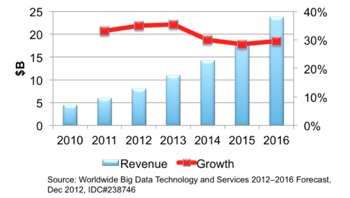Red Hat is by no means any stranger to either Big Data or the open hybrid cloud, having been closely involved with both efforts for several years already. But with the company’s announcement last week of a fresh strategic direction in those areas, it’s clearly embarking on a new path.
Not only did Red Hat discuss a new focus on providing solutions for enterprises with Big Data analytics workloads, but it also announced that it will contribute its Red Hat Storage Hadoop plug-in to the Apache Hadoop open community, thus transforming Red Hat Storage into a fully-supported, Hadoop-compatible file system for Big Data  environments.
environments.
In addition, Red Hat is building a network of ecosystem and enterprise integration partners, it said.
Big Data ‘A Slam-Dunk’ for Red Hat
“The fact that Red Hat is now in the game is a slam-dunk for them in many ways, because they have been providing the plumbing to all the Big Data elements for the longest time,” Ashish Nadkarni, a research director at IDC, told Linux.com.
“Red Hat Enterprise Linux is a venerable operating system, and it has the framework in place to support a full-fledged storage stack,” Nadkarni explained. Red Hat Storage Server, meanwhile, “is based on Gluster, which has been at the front of Big Data.”
Then, too, “you have their contributions and tremendous influence on the open source community, which is where most of the Big Data action happens,” he added. “Finally, there is their JBoss middleware and application-level stuff, which can be used for most layered Big Data applications.”
In short, “now that they’ve come out in front and announced such a strategy, they are going to get more traction,” Nadkarni predicted. “Now they can start executing.”
Cloud Storage is Iffy
From a strategic point of view, “Red Hat’s announcement is important both to its business and to its standing in the open source community,” Charles King, principal analyst with Pund-IT, told Linux.com. “Hadoop is going to be an increasingly important tool set and solution set for businesses of every size, but particularly for enterprises dealing with petabytes of data that they are trying to wrest some value out of.”
Red Hat’s cloud storage offering was the one piece King wasn’t so sure about.
“The real question to me there is, how likely it is that a Red Hat customer is really going to want to use Red Hat for storage management as opposed to a more deeply knowledgeable and experienced storage partner like EMC,” King explained.
“It’s a competitive positioning thing,” he added. “The sense I got out of Red Hat’s announcement is that it is trying to be all things to all people. I don’t know how well that’s going to play, especially in an area as complex as cloud storage.”
Red Hat as Your Platform
Still, nearly 72 percent of enterprise respondents to the Linux Foundation’s “Linux Adoption Trends 2012: A Survey of Enterprise End Users” report indicated that they choose Linux to support Big Data.
In addition to being a leader in such deployments, Red Hat Enterprise Linux has a particular strength in distributed architectures and features that address critical Big Data needs, the company said.
In fact, 2013 will be the year of “Big Data in the Cloud,” IDC predicts, with growth of the Big Data infrastructure market to nearly $24 billion by 2016.
“When people build private or hybrid clouds, they tend to go with a commercial distribution because of the support model,” Nadkarni concluded. “Red Hat is known for that, so from that side, they’re already riding the wave.
“Now that they have announced this strategy,” he added, “they can go to customers and say, ‘if you want to deploy Hadoop or OpenStack or custom analytics integration, we can be your platform.”
END



